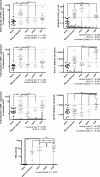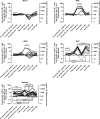A Comparison of the Adaptive Immune Response between Recovered Anthrax Patients and Individuals Receiving Three Different Anthrax Vaccines
- PMID: 27007118
- PMCID: PMC4805272
- DOI: 10.1371/journal.pone.0148713
A Comparison of the Adaptive Immune Response between Recovered Anthrax Patients and Individuals Receiving Three Different Anthrax Vaccines
Abstract
Several different human vaccines are available to protect against anthrax. We compared the human adaptive immune responses generated by three different anthrax vaccines or by previous exposure to cutaneous anthrax. Adaptive immunity was measured by ELISPOT to count cells that produce interferon (IFN)-γ in response to restimulation ex vivo with the anthrax toxin components PA, LF and EF and by measuring circulating IgG specific to these antigens. Neutralising activity of antisera against anthrax toxin was also assayed. We found that the different exposures to anthrax antigens promoted varying immune responses. Cutaneous anthrax promoted strong IFN-γ responses to all three antigens and antibody responses to PA and LF. The American AVA and Russian LAAV vaccines induced antibody responses to PA only. The British AVP vaccine produced IFN-γ responses to EF and antibody responses to all three antigens. Anti-PA (in AVA and LAAV vaccinees) or anti-LF (in AVP vaccinees) antibody titres correlated with toxin neutralisation activities. Our study is the first to compare all three vaccines in humans and show the diversity of responses against anthrax antigens.
Conflict of interest statement
Figures




Similar articles
-
Toxin-neutralizing antibodies elicited by naturally acquired cutaneous anthrax are elevated following severe disease and appear to target conformational epitopes.PLoS One. 2020 Apr 15;15(4):e0230782. doi: 10.1371/journal.pone.0230782. eCollection 2020. PLoS One. 2020. PMID: 32294093 Free PMC article.
-
Lethal factor antibodies contribute to lethal toxin neutralization in recipients of anthrax vaccine precipitated.Vaccine. 2017 Jun 8;35(26):3416-3422. doi: 10.1016/j.vaccine.2017.05.006. Epub 2017 May 11. Vaccine. 2017. PMID: 28504191 Free PMC article.
-
Analysis of anti-protective antigen IgG subclass distribution in recipients of anthrax vaccine adsorbed (AVA) and patients with cutaneous and inhalation anthrax.Vaccine. 2007 Feb 26;25(10):1780-8. doi: 10.1016/j.vaccine.2006.11.028. Epub 2006 Nov 27. Vaccine. 2007. PMID: 17229495
-
Molecular basis for improved anthrax vaccines.Adv Drug Deliv Rev. 2005 Jun 17;57(9):1266-92. doi: 10.1016/j.addr.2005.01.028. Epub 2005 Apr 21. Adv Drug Deliv Rev. 2005. PMID: 15935874 Review.
-
Neutralizing antibody and functional mapping of Bacillus anthracis protective antigen-The first step toward a rationally designed anthrax vaccine.Vaccine. 2016 Jan 2;34(1):13-9. doi: 10.1016/j.vaccine.2015.11.025. Epub 2015 Nov 21. Vaccine. 2016. PMID: 26611201 Review.
Cited by
-
Toxin-neutralizing antibodies elicited by naturally acquired cutaneous anthrax are elevated following severe disease and appear to target conformational epitopes.PLoS One. 2020 Apr 15;15(4):e0230782. doi: 10.1371/journal.pone.0230782. eCollection 2020. PLoS One. 2020. PMID: 32294093 Free PMC article.
-
Zoonoses under our noses.Microbes Infect. 2019 Jan-Feb;21(1):10-19. doi: 10.1016/j.micinf.2018.06.001. Epub 2018 Jun 18. Microbes Infect. 2019. PMID: 29913297 Free PMC article. Review.
-
Anthrax Vaccine Precipitated Induces Edema Toxin-Neutralizing, Edema Factor-Specific Antibodies in Human Recipients.Clin Vaccine Immunol. 2017 Nov 6;24(11):e00165-17. doi: 10.1128/CVI.00165-17. Print 2017 Nov. Clin Vaccine Immunol. 2017. PMID: 28877928 Free PMC article.
-
Impact of HLA Polymorphism on the Immune Response to Bacillus Anthracis Protective Antigen in Vaccination versus Natural Infection.Vaccines (Basel). 2022 Sep 20;10(10):1571. doi: 10.3390/vaccines10101571. Vaccines (Basel). 2022. PMID: 36298436 Free PMC article.
-
Anthrax Vaccines in the 21st Century.Vaccines (Basel). 2024 Feb 3;12(2):159. doi: 10.3390/vaccines12020159. Vaccines (Basel). 2024. PMID: 38400142 Free PMC article. Review.
References
-
- Turner WC, Kausrud KL, Krishnappa YS, Cromsigt JP, Ganz HH, Mapaure I, et al. Fatal attraction: vegetation responses to nutrient inputs attract herbivores to infectious anthrax carcass sites. Proceedings Biological sciences / The Royal Society. 2014;281(1795). Epub 2014/10/03. 10.1098/rspb.2014.1785 ; PubMed Central PMCID: PMCPmc4213624. - DOI - PMC - PubMed
Publication types
MeSH terms
Substances
Supplementary concepts
Grants and funding
LinkOut - more resources
Full Text Sources
Other Literature Sources
Medical
Miscellaneous

